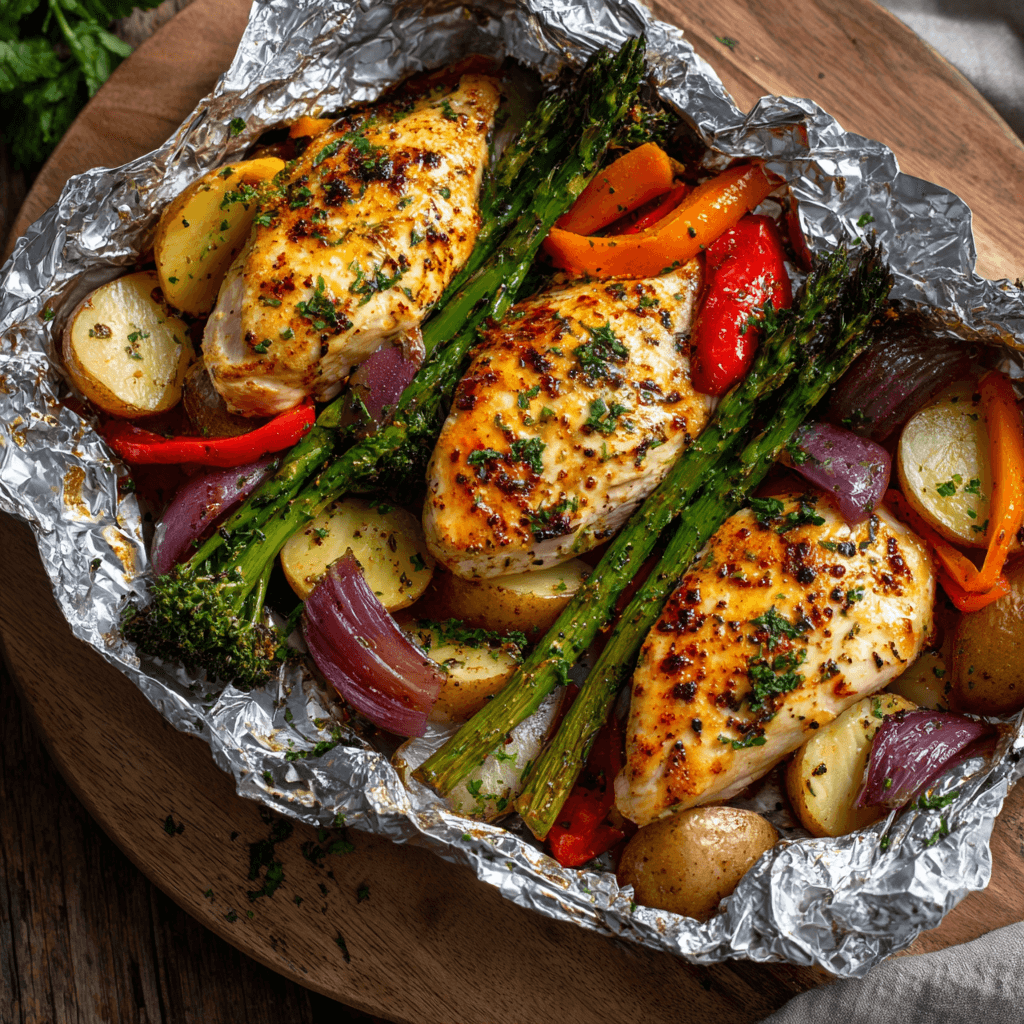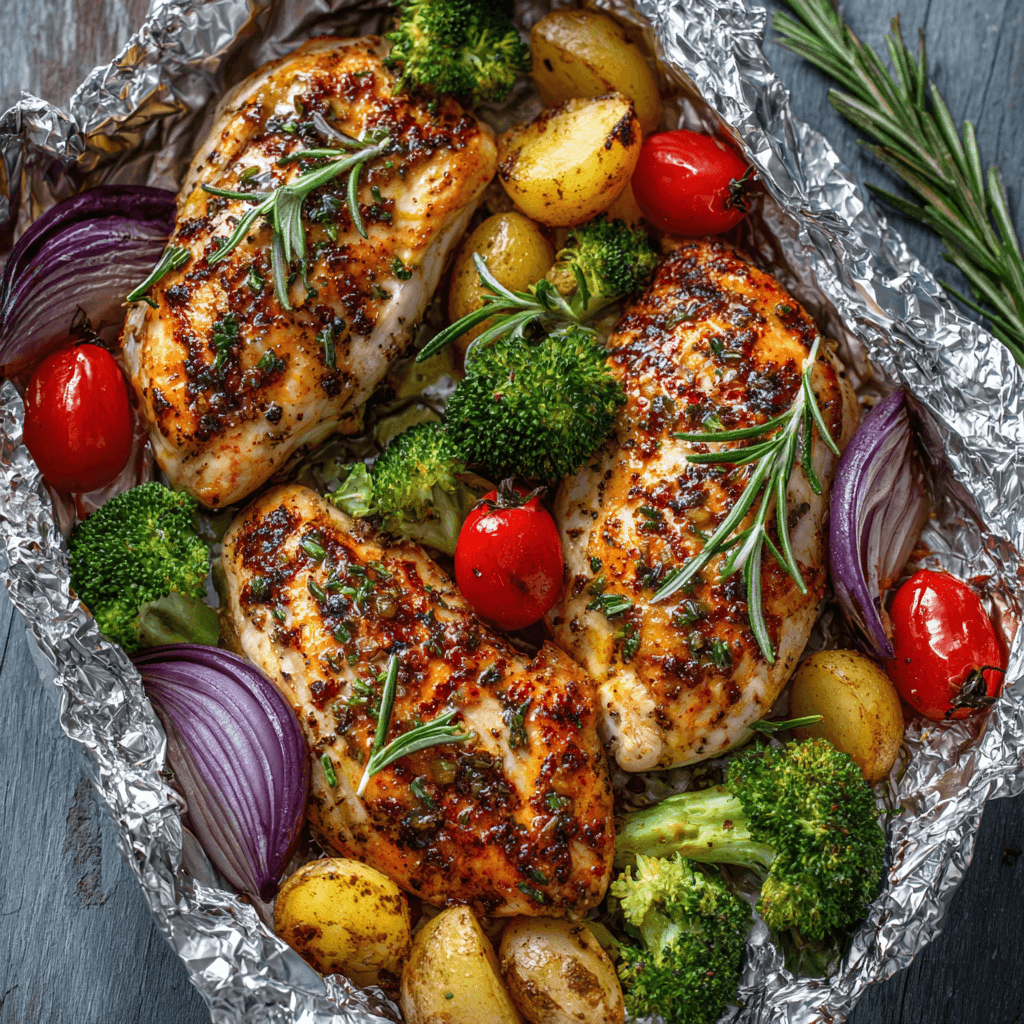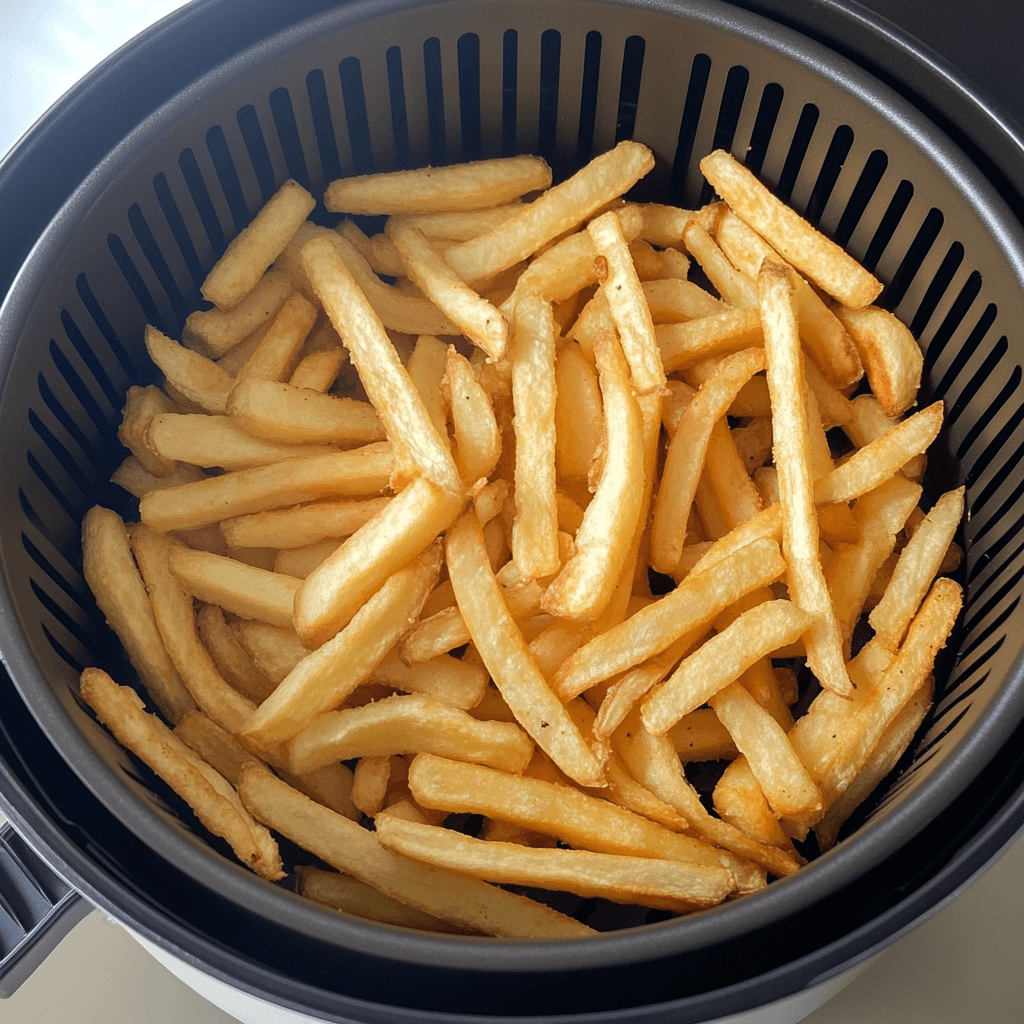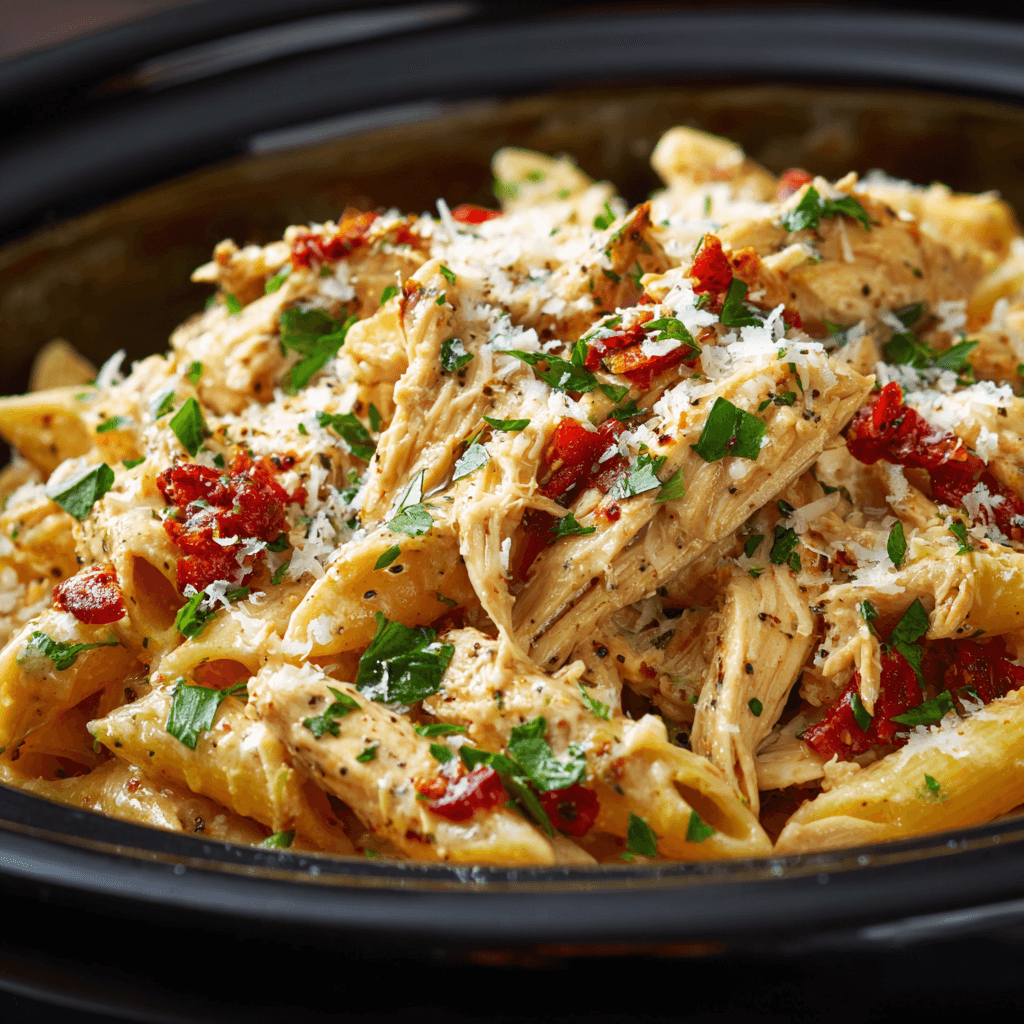Introduction to Chicken Foil Packets
What are Chicken Foil Packets?
Chicken foil packets are a simple, flavorful cooking method where seasoned chicken and various ingredients like vegetables, herbs, and sauces are wrapped in aluminum foil and then baked, grilled, or even cooked over a campfire. Each packet acts as an individual sealed parcel, locking in moisture and infusing the chicken with the vibrant flavors of the ingredients inside.
These packets are incredibly versatile—you can customize them to suit different dietary needs, flavor profiles, or whatever you have in the fridge. From zesty lemon-garlic chicken with asparagus to spicy Tex-Mex-inspired combinations, the possibilities are nearly endless.
Why They Are Popular for Weeknight Meals
Chicken foil packets have become a favorite for busy weeknights—and for good reason. They offer a no-mess, no-fuss way to prepare a wholesome, balanced meal in a single bundle. Here’s why home cooks love them:
- Minimal Cleanup: Since everything is cooked inside the foil, there are fewer dishes to wash after dinner.
- Quick Prep: You can assemble the packets ahead of time and refrigerate until ready to cook.
- Customizable Portions: Each packet can be tailored to individual preferences or dietary restrictions.
- Moist and Juicy Results: The sealed foil traps steam, which helps the chicken stay tender and juicy.
- Healthy Cooking: With lean protein, fresh vegetables, and little added fat, foil packets are a naturally health-conscious choice.
Whether you’re baking them in the oven or throwing them on the grill, chicken foil packets make weeknight cooking faster, cleaner, and more delicious.
Benefits of Cooking with Foil Packets
Minimal Cleanup
One of the biggest advantages of foil packet cooking is the minimal cleanup it requires. Since all the ingredients are sealed inside a single foil pouch, there are no pots or pans to scrub afterward. Just cook, serve, and toss the foil—perfect for anyone who wants a hearty, home-cooked meal without the mess.
Flavor Infusion
Foil packets act like mini steam ovens. As the ingredients cook together in their own juices, the flavors meld beautifully. The chicken absorbs the seasoning, herbs, and aromatic steam from the veggies and sauces, resulting in deeply flavorful, tender meat in every bite.
Great for Grilling and Camping
Foil packets are tailor-made for outdoor cooking. Whether you’re firing up the backyard grill or preparing a campfire meal, they’re a convenient, fire-friendly solution. No special cookware needed—just place the packets over heat and let them work their magic. They’re also easy to pack and prep ahead, making them a camping favorite.
Choosing the Right Ingredients
Best Cuts of Chicken to Use
Boneless, skinless chicken breasts and thighs are the top choices for foil packet recipes.
- Chicken breasts cook quickly and stay lean, making them ideal for lighter meals.
- Chicken thighs are more forgiving and flavorful, staying juicy even if slightly overcooked—great for grilling or longer cooking times.
You can also use chicken tenders or cut larger pieces into chunks for faster cooking and easier portioning.
Vegetable Combinations
Veggies in foil packets should cook at the same rate as the chicken, or be sliced thinly to ensure even doneness. Some excellent options include:
- Quick-cooking veggies: zucchini, bell peppers, cherry tomatoes, mushrooms, and green beans
- Hearty additions: thinly sliced potatoes, carrots, sweet potatoes, or corn (cut small)
Mix and match for color, texture, and flavor balance. Think of the foil packet as a complete one-dish meal.
Seasoning Blends
The right seasoning can elevate your foil packet from simple to sensational. You can go as basic or bold as you like:
- Classic combos: garlic, lemon, rosemary, olive oil
- Southwest flair: chili powder, cumin, paprika, lime juice
- Asian-inspired: soy sauce, ginger, sesame oil, green onions
- Mediterranean mix: oregano, olives, sun-dried tomatoes, feta
Dry rubs, marinades, or a drizzle of sauce all work well—just be sure not to overdo the liquid, as too much can cause the packet to leak or steam too aggressively.
Foil Packet Preparation Techniques
How to Properly Fold Foil Packets
Folding foil packets correctly ensures even cooking and prevents leaks. Follow these simple steps:
- Start with a large sheet of heavy-duty aluminum foil, about 12×16 inches or larger for full meals.
- Place the ingredients in the center, leaving space around the edges for steam to circulate.
- Fold the long sides of the foil over the food to meet in the center, then fold them together tightly in small overlapping folds.
- Fold up the short sides, again using small, tight folds to seal the packet completely.
- Make sure there’s a bit of room inside for air and steam to circulate—don’t pack it too tightly.
This creates a secure, steam-trapping pouch that helps cook food evenly and keep it juicy.
Do’s and Don’ts of Sealing
Do:
- Use heavy-duty foil to avoid tearing or leaking.
- Seal tightly to prevent juices from escaping.
- Double wrap if cooking over open flames for added protection.
Don’t:
- Don’t overfill—crowded packets cook unevenly.
- Don’t leave gaps or loose folds, as steam can escape.
- Don’t stack packets on top of each other during cooking—this blocks heat and can cause uneven results.
Foil vs Parchment Paper
While foil is the go-to material for foil packets, parchment paper can also be used—especially for oven baking.
- Foil is best for grilling and campfires due to its durability and heat resistance.
- Parchment paper offers a non-stick surface and a lighter touch, ideal for more delicate flavors or health-conscious cooking. However, it can’t go on an open flame unless wrapped in foil for protection.
For best results, you can also use a parchment-inside, foil-outside combo: the parchment cradles the food, while the foil locks in the heat.
Cooking Methods for Chicken Foil Packets
Oven Baking
Temperature: 375°F–400°F (190°C–200°C)
Time: 25–35 minutes depending on thickness
Place foil packets on a baking sheet for stability and easy transfer. Bake until the chicken reaches an internal temperature of 165°F (74°C). For a slightly roasted finish, open the packets during the last 5–7 minutes of cooking.
Grilling Techniques
Heat: Medium-high grill (about 400°F / 200°C)
Time: 20–30 minutes
Place packets directly on the grill grates and cook with the lid closed. Flip once halfway through for even cooking. Avoid placing packets over high flames, as direct fire can scorch the foil and burn the food.
Tip: If you’re cooking multiple packets, rotate their positions on the grill for consistent heat exposure.
Campfire Cooking
Setup: Place packets on hot embers or on a grill grate over the fire.
Time: 20–30 minutes
Campfire cooking delivers a smoky, rustic flavor. Be sure to use double-wrapped foil and tongs or a grill tool for safe handling. Rotate packets every 10 minutes to avoid burning on one side.
Bonus Tip: Let the packets rest a few minutes after cooking to allow juices to settle before opening.
Best Seasonings and Marinades
Herb and Garlic Blends
A timeless combination, herb and garlic seasoning creates a fresh, aromatic flavor that pairs beautifully with chicken and vegetables.
Try this blend:
- Minced garlic
- Fresh or dried rosemary, thyme, and parsley
- Olive oil
- A splash of lemon juice
- Salt and black pepper
This combination works wonderfully in foil packets with carrots, potatoes, and green beans for a well-rounded, comforting meal.
Spicy BBQ Flavors
For bold, smoky flavors with a kick, BBQ-inspired seasonings are a hit—especially on the grill.
Flavor profile options:
- Smoked paprika
- Chili powder or cayenne
- Brown sugar for a touch of sweetness
- Garlic and onion powder
- Your favorite BBQ sauce for added moisture
This works well with sweet corn, red onions, and bell peppers for a Southern-style packet.
Asian-Inspired Marinades
For a savory, umami-rich option, try an Asian-style marinade. These flavors work well with quick-cooking vegetables like snap peas, bok choy, or shredded carrots.
Key ingredients:
- Soy sauce or tamari
- Sesame oil
- Fresh ginger and garlic
- Rice vinegar or lime juice
- A drizzle of honey or hoisin sauce
- Green onions and sesame seeds for garnish
Let the chicken marinate for 15–30 minutes before sealing the packet for maximum flavor.

Chicken Foil Packet Recipe Ideas
Classic Chicken and Veggies
Ingredients:
- Boneless, skinless chicken breast or thigh
- Baby potatoes, carrots, and green beans
- Olive oil, garlic, Italian seasoning, salt, and pepper
This all-in-one meal is a great introduction to foil packet cooking—balanced, satisfying, and easy to customize.
Mediterranean Chicken Packets
Ingredients:
- Chicken thighs or breasts
- Cherry tomatoes, zucchini, red onion, and Kalamata olives
- Crumbled feta cheese
- Olive oil, oregano, lemon juice, garlic
This combination brings bright, tangy, and herbaceous flavors to life. Serve with couscous or pita for a complete Mediterranean feast.
Creamy Ranch Chicken
Ingredients:
- Chicken breast
- Broccoli florets, thin potato slices, and shredded cheese
- Ranch seasoning mix
- A spoonful of cream cheese or sour cream (optional) for extra richness
This family-friendly foil packet is indulgent yet simple—perfect for picky eaters or comfort food nights.
Customizing for Dietary Needs
Low-Carb and Keto Versions
Foil packets are a natural fit for low-carb and keto lifestyles. Swap starchy vegetables like potatoes and corn for lower-carb options:
- Great keto veggies: zucchini, cauliflower, broccoli, spinach, mushrooms, and bell peppers
- Use olive oil, butter, or avocado oil as your fat source
- Stick with high-fat marinades (like creamy garlic butter or pesto) and avoid sugary BBQ sauces or glazes
You’ll still get a satisfying, filling meal without the carbs.
Dairy-Free Options
To make dairy-free foil packets, skip cheese, butter, or cream-based ingredients. Instead:
- Use olive oil or dairy-free margarine
- Add flavor with coconut milk, dairy-free pesto, or herb-infused oils
- For creaminess, incorporate avocado slices after cooking or use dairy-free cream cheese substitutes
Plenty of seasoning and herbs will keep the flavor bold without needing dairy.
Gluten-Free Adjustments
Most foil packet ingredients are naturally gluten-free, but it’s still important to double-check your seasonings and sauces:
- Ensure soy sauce is labeled gluten-free (or use tamari or coconut aminos)
- Check packaged seasoning blends and marinades for hidden gluten or additives
- Avoid any breadcrumb toppings unless using certified gluten-free crumbs
With a few small swaps, foil packets can be completely safe and satisfying for those avoiding gluten.
How Long to Cook Chicken in Foil Packets
Cooking Times Based on Method and Thickness
Cooking times will vary depending on your method and the thickness of the chicken. Here’s a general guideline:
- Oven (375–400°F / 190–200°C)
- Chicken breasts (1-inch thick): 25–30 minutes
- Chicken thighs: 30–35 minutes
- Chicken chunks or tenders: 20–25 minutes
- Grill (medium-high heat, ~400°F / 200°C)
- Whole breasts/thighs: 20–30 minutes
- Smaller pieces: 15–20 minutes
- Flip once halfway through
- Campfire (on hot coals or grate)
- Full packets: 25–30 minutes
- Rotate packets for even cooking
- Use double foil for better insulation
How to Test for Doneness
To ensure your chicken is safely cooked and juicy:
- Use a meat thermometer: internal temperature should reach 165°F (74°C)
- Cut into the thickest part of the chicken—no pink color, and juices should run clear
- Let packets rest for 3–5 minutes before opening, which helps retain juices and finalize cooking
Tips for Juicy and Tender Chicken
Using Marinades
Marinating your chicken before cooking is one of the best ways to lock in flavor and moisture. Even a quick 15–30 minute marinade can make a big difference.
Tips for better marinades:
- Use an acid (like lemon juice, vinegar, or yogurt) to tenderize
- Include oil to help the marinade penetrate the meat
- Add herbs, spices, and garlic for maximum flavor
- Don’t marinate too long—especially with acidic bases—4 hours is plenty for chicken breasts
Layering Ingredients Properly
The order in which you layer ingredients inside the foil packet affects cooking and moisture:
- Place vegetables that take longer to cook (like potatoes or carrots) on the bottom
- Put the chicken directly on top—this ensures even cooking and lets juices drip down for extra flavor
- Add quick-cooking veggies (like zucchini or bell peppers) on top or around the sides
- Finish with sauces, herbs, or a squeeze of lemon on top to avoid soggy textures
Proper layering helps everything cook at the right pace and prevents dry chicken or undercooked veggies.
Timing and Temperature Control
Cooking too long or too hot can dry out your chicken. Stick to these key principles:
- Don’t overcook: Remove packets as soon as internal temp hits 165°F (74°C)
- Avoid high direct heat: This can scorch the foil and dry out the food inside
- Let packets rest for a few minutes after cooking to let the juices redistribute before opening
Monitoring cook time and using a thermometer is the easiest way to ensure juicy results every time.
Make-Ahead and Freezer Tips
How to Prep Foil Packets in Advance
Foil packets are ideal for busy weeks—just prep them ahead and cook when ready.
Here’s how:
- Assemble your foil packets with raw chicken, veggies, and seasonings
- Seal tightly and label with contents and date
- Store in the refrigerator for up to 24 hours before cooking
- Remove from fridge about 15 minutes before cooking to take the chill off
This is great for meal prepping several nights’ worth of healthy dinners in one go.
Freezer-Friendly Chicken Packets
Foil packets can also be frozen for longer-term storage. To freeze:
- Use freezer-safe heavy-duty foil, and wrap packets tightly to prevent freezer burn
- Label with cooking instructions and date
- Freeze flat on a tray, then stack once solid
- Store for up to 3 months
Cooking from frozen?
- Add an extra 10–15 minutes of cook time
- Always check internal temp—165°F (74°C) is the safe zone
- Or thaw overnight in the fridge for quicker, more even cooking
Freezer-friendly foil packets are perfect for camping trips, busy weeknights, or last-minute guests.
Chicken Foil Packets for Meal Prep
Storing and Reheating
Chicken foil packets are ideal for meal prep because they store well and reheat easily.
Storing tips:
- Let packets cool completely before storing
- Store sealed packets in the fridge for up to 4 days
- For extra convenience, store individual portions in containers if you’ve already opened the foil
Reheating tips:
- Oven: Reheat in the foil at 350°F (175°C) for 10–15 minutes
- Microwave: Open the foil and transfer to a microwave-safe plate; cover and heat in 1-minute intervals
- Avoid over-reheating, which can dry out the chicken
Portion Control
Each foil packet is naturally portioned, making it easy to control servings without extra measuring.
- Use smaller packets for kids or lighter meals
- Standard size: 4–6 oz of chicken + 1 cup vegetables
- For bulk cooking, prep several packets with varied ingredients to avoid meal fatigue
Foil packets are also great for customizing to fit calorie, protein, or carb goals.
Balanced Meal Tips
To keep your foil packets nutritionally balanced:
- Include lean protein (chicken breast or thigh)
- Add colorful vegetables for fiber and nutrients
- Drizzle with healthy fats like olive oil or avocado
- Serve with a side of whole grains (quinoa, brown rice) if desired—or keep it low-carb with just veggies
The foil packet format makes it easy to build a full, wholesome meal with minimal fuss.
Common Mistakes to Avoid
Overcooking the Chicken
The most common issue with foil packets is dry chicken. To avoid this:
- Monitor cook time carefully
- Use a meat thermometer to check for 165°F (74°C) internal temp
- Don’t cut the chicken too thin, or it’ll cook too fast
- Avoid cooking at excessively high heat (especially on grills or campfires)
Incorrect Foil Folding
Poorly folded packets can leak, burn, or cook unevenly.
Avoid these folding mistakes:
- Too tight: No room for steam = uneven cooking
- Too loose or open: Steam escapes = dry food
- Thin or torn foil: Increases risk of mess or burning on the grill
Use heavy-duty foil and practice proper sealing techniques (see earlier section on folding).
Flavorless Combinations
If your packet turns out bland, it’s usually due to one of the following:
- Not enough seasoning or marinade
- Ingredients that don’t complement each other
- No acid or sauce to brighten the flavors
Fix this by:
- Layering with fresh herbs, citrus, or vinegars
- Using flavorful blends or spice mixes
- Adding a finishing sauce or fresh garnish after cooking (like pesto, yogurt, or salsa)
Chicken Foil Packets for Kids and Picky Eaters
Kid-Friendly Combinations
Making chicken foil packets appealing to kids is all about familiar flavors and simple ingredients. Here are a few winning combinations:
- Cheesy Chicken & Broccoli: Chicken breast, broccoli florets, shredded cheddar, olive oil, and a pinch of garlic powder
- Pizza Packet: Chicken, marinara sauce, mozzarella cheese, bell peppers, and a sprinkle of oregano
- BBQ Chicken & Corn: Chicken tenders, sweet corn, diced potatoes, BBQ sauce, and a touch of honey
Keep the seasonings mild and the textures soft for younger kids.
Fun Presentation Ideas
Presentation can turn dinner into a fun experience for kids:
- Let them help assemble their own packets—choose ingredients and fold their foil
- Use cookie cutters to shape veggies like carrots or zucchini
- Label each packet with their name in permanent marker or colored stickers
- Serve with dipping sauces like ranch, ketchup, or honey mustard to add fun and flavor
Making the meal interactive increases the chances they’ll enjoy it—even the veggies!
Frequently Asked Questions About Chicken Foil Packets
How Long Do Foil Packets Last?
Cooked chicken foil packets can be safely stored in the refrigerator for up to 4 days.
If frozen, they’ll last for up to 3 months. Always let the packets cool before sealing and storing.
Can You Reuse Foil?
Technically, foil can be reused if it’s clean and not torn, but for food safety and structural integrity, it’s best to use fresh foil for each packet, especially if you’re cooking raw meats.
If you’re baking or grilling veggies separately, lightly used foil may be reused once.
What’s the Best Foil to Use?
Use heavy-duty aluminum foil to prevent tears and ensure the packets hold up during cooking.
- For grilling or campfire cooking, double-wrap for extra strength
- Avoid non-stick foil if you’re sealing the packet tightly, as the coating may transfer at high heat
- If baking, you can line the inside with parchment paper for a non-stick surface and easy cleanup
If you enjoy easy, mess-free meals like chicken foil packets, you might also love trying other flavorful yet low-effort chicken dishes. For example, these delicious and easy thin sliced chicken breast recipes are quick to cook and highly versatile—great for weeknights. If you’re meal prepping or prefer bold, crowd-pleasing flavors, this ultimate crack chicken recipe delivers creamy comfort in every bite. You can also explore other high-protein options with this ultimate guide to boneless skinless chicken thigh recipes, which pairs perfectly with veggies just like foil packet meals. For something with a tangy kick, check out this perfect chipotle chicken recipe—a great alternative if you’re craving spice.
USDA Safe Minimum Internal Temperatures
- Anchor text suggestion: Check the USDA’s recommended internal temperatures to ensure your chicken is safely cooked.
Conclusion: Why Chicken Foil Packets Should Be in Your Weekly Rotation
Chicken foil packets check all the right boxes—they’re easy to prepare, incredibly versatile, and require almost no cleanup. Whether you’re cooking for a busy family, planning make-ahead meals, or trying to eat healthier without sacrificing flavor, foil packets are a reliable solution that delivers every time.
With endless ingredient combinations, customizable seasoning blends, and cooking methods that suit ovens, grills, or even campfires, there’s no reason not to add them to your weekly meal plan. Plus, they’re a fun and foolproof way to get creative in the kitchen without making a mess.
So the next time you’re stuck wondering what to make for dinner, skip the stress and wrap up something simple, juicy, and satisfying. Chicken foil packets aren’t just a trend—they’re a time-saving staple worth repeating.





